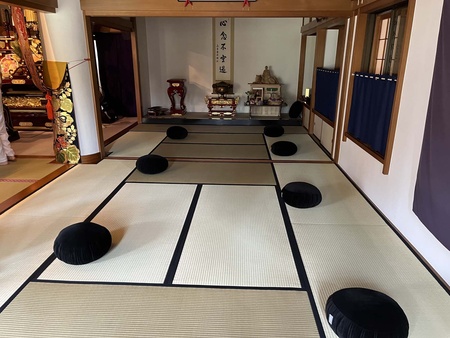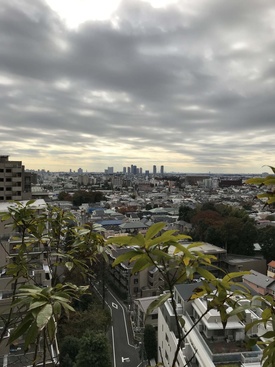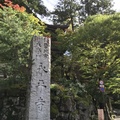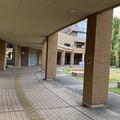I once met a travelling monk from Japan. After a full career and family life, he retired from both to embark on a spiritual journey. He received Buddhist ordination and uprooted himself from the soil of his familiar. His new life chapter had recently begun when we crossed paths in Los Angeles, where he was in between stays at Zen practice centers in Oregon and Iowa.
“What about you wife and kids?” I asked. “How are they doing without you?”
“They are taken care of,” he answered. “My children are grown and have families of their own, and my wife supports me. I am free.”
He used the word unsui, a Zen term meaning “floating cloud.” During the late autumn of his life, he was floating around the world freed from family and work responsibilities with saggy eyelids and blotchy spots on his freshly shaved scalp hinting at the price paid for his liberation.
The monk put hands together in gassho and bowed to our temple priest. His back remained parallel to the floor for one (maybe two) heartbeats. “Clean the toilets using these brushes and cloths,” Kojima Sensei said. The monk adjusted the folds of his black robe and repeated the bow. He walked towards the restroom carrying the bucket of supplies, stopping to untangle his sleeves. He looked like someone more comfortable giving rather than receiving orders.
I saw him as a character in a dark comedy skit: He’s wearing a business suit and tie presiding over a long table with starched white linens, crystal goblets, heavy silverware, and a matched set of corporate yes-men sitting back straight. He commands them to leave their wives and children to become one with ultimate reality. “HAI,” the men reply in unified obeisance.
The memory of that wandering monk preoccupied me as I too embarked on a spiritual journey with the change of seasons in my own life. Although I grew up going to a Buddhist temple, I’d never been particularly religious. But I returned afresh to Buddhism when my kids reached college age and my marriage had withered and died.
During my year of teaching in Japan, I frequented temples and practice centers and retreated to Eiheiji, a famous Zen monastery. Most of all, I sat zazen meditation—at home, in temples, with practice groups, and on crowded trains. One time I sat with an exclusive group whose august, English-speaking abbot attracted to his zendo foreign executives from Fortune 500 companies. I was introduced to the abbot by Ken, an architect who knew the abbot’s wife and was the brother in-law of my friend.
One autumnal Saturday morning, Ken picked me up in his late-model sports coupe and we drove the short route from the train station to the abbot’s house. The free-standing homes in this trendy part of town were unlike the cookie-cutter suburban houses where I lived in Tokyo. Each was a different shape and style—Italian villa next to English Tudor next to Avant Garde modern.
As expected, there was no on-street parking in front of the abbot’s house, so Ken pulled into a space that looked like it was reserved for residents. He exited the car and bound up the stairs to the front door—he had been here before.
The abbot appeared in a house kimono, but after acknowledging Ken’s greeting, he brusquely pointed to the house next door, as if to say, “This is my private home; don’t bother me here!” Ken returned to the car a bit unsettled. He didn’t know that the abbot also owned the large adjacent house and that it was used as a zendo for his zazen group.
I followed Ken’s tentative steps up the stairway to the next-door house. After entering the unlocked door, we fumbled around until a neatly dressed, bespectacled man gave us instructions: “Put your shoes here, sign-in there, and walk this way to the zendo.”
When I spotted the black zafu cushions laid out along the walls, I was reassured that we had come to the right place. I stood before a zafu and bowed. Then I sat down on it, crossed my legs, turned my body to the wall and waited. Ken stood before a zafu next to me and did the same. Outside the zendo I might have looked to him for guidance, but in here he followed me.
There were five others already in the room and a few more arrived after us—bare feet rasping along the woven tatami mat flooring. The bell sounded and we sat in silence. After forty minutes, we unfolded our legs, arose, and transitioned to slow walking zazen during which I noticed that the abbot wasn’t in the zendo.
Ding. Not long after the second round of zazen sitting had begun, the bespectacled man tapped Ken on his shoulder and spoke softly to him. Ken got up and told me to follow. We were going to talk with the abbot in a private room next to the zendo.
Manly and handsome with no trace of gray in his short, perfectly styled hair, the abbot could pass for the actor Toshio Mifune’s younger brother. Ken and I sat facing him, side by side as if we were kneeling in church but with our shins flat on the tatami and legs tucked underneath our bottoms.
“I hear that you have been to Eiheiji and have been doing zazen,” the abbot said in unaccented English. “I am not a regular monk like those at Eiheiji. I am a businessman who was ordained by my father.”

“I appreciate Soto Zen teachings,” he continued. “But the people who come here are not necessarily Buddhist. Each has a koan (Zen riddle) they are using to reach enlightenment.” He then asked me, “Do you want enlightenment?”
I was taken aback. Was this a test? Two years ago, I would have said yes and asked if I could begin koan training with him. At that time in LA, I was attached to a well-known Zen book in which various foreigners and Japanese recount the enlightenment (satori) experiences they had achieved through ruminating intensively on a koan (e.g., “What is the sound of one hand clapping?” or “What is Mu”?). Such practitioners became especially ripe for satori during extended periods of all-day zazen sitting (sesshin) in which they worked on their koan even while sleeping. Their monk teacher pushed them on with militant determination even as he hit them with the “stick of compassion” during zazen whenever their head swayed with drowsiness. “Push harder! Do you want satori?”
That book was like a bible to me. I was inspired by how normal people who had regular jobs and were not ordained monks had managed to crack their egoic consciousness to become one with ultimate reality. I thought about their experiences as I prepared for my first very own week-long sesshin. Before starting it, I told Kojima Sensei that I was going for satori. He laughed. “Satori is just chemicals in your brain that makes you feel good,” he said. “Don’t get attached to that feeling; just sit without thinking about enlightenment.”
I didn’t know it at the time, but satori meant something different to different schools of Zen. Kojima Sensei and my home temple in Los Angeles belonged to the Soto sect which didn’t dwell on the big bang of enlightenment and instead saw it in everyday activities like cooking, cleaning, bathing, and even going to the toilet. This contrasted with the teachings of the abbot that Ken and I met in Tokyo—whose father, it turned out, had attained satori under the very same stick-wielding teacher who had induced the enlightenment experiences that I had read about.
“No. I don’t want enlightenment,” I said to the abbot. “I’m here simply to observe and learn about your zazen group. I already have my own group in Tokyo.”
That was it. Ken and I gathered our things and left the room. I suppose we could have returned to the zendo and sat out the zazen session but what was the point since I wouldn’t be joining the group. Although Ken was interested in zazen, he too was ready to go. We left the house with him still carrying the omiyage gift that he had brought for the abbot.
Afterwards, Ken and I discussed the meaning of enlightenment while sitting on the balcony of his high-rise condo eating the sweet cakes that had been intended for the abbot. I explained to him that the Soto school saw satori as nothing special and hence we shouldn’t fixate on achieving it—or anything—through Zen practice. Zazen wasn’t a means to an end. Zazen was simply zazen.
“That sounds like a koan,” Ken said as he poured tea for the two of us.
“Maybe that’s why I can’t understand it,” I said. “Truth be told, I’m still seeking to get something from Zen.” My zazen groups in LA and Tokyo, I confessed, were supports to get me through the pain of separating (and ultimately divorcing) from my wife and breaking up my family.
Indeed, had my marriage remained happy and fulfilling, I wouldn’t had thought about practicing zazen let alone going on a spiritual journey. Yet given the irreconcilable state of affairs with my wife, I sought to turn lemons into lemonade, telling myself that in practicing Zen I was following the path of Prince Siddhartha, who 2,600 years ago in India left his wife and young son to find the meaning of existence that would benefit all sentient beings.
But I wasn’t a true “home leaver” like the would-be Buddha or the floating cloud monk I met in LA or the Toshio Mifune lookalike abbot. I wanted the best of both spiritual and ordinary lives—to leave one home but find another.
“I hear you’re looking for someone special,” Ken said as he handed me another sweet from the abbot’s intended omiyage. I nodded and accepted the offering. Ken asked my age and was pleased to learn that I was younger than he had thought.
He leaned in and started to list his single female friends, debating with himself about whether they might be compatible with me. He enjoyed playing matchmaker, but I sounded a note of caution. “I can’t speak Japanese, I don’t have a permanent job in Japan, and there’s little chance that I’m going to find one commensurate with my skillset and work experience.”
“But you said that you wanted to remain permanently in Tokyo?”
“Yes. But not at all costs.” As it turned out, I wasn’t ready to give up my tenured position in LA for anything less than a lateral move to a Japanese university. Like my home leaving—I wanted the best of both worlds. This was my “middle way.”
Ken’s face turned blank for a few seconds while his mind re-sorted his matchmaking database. Before I could apologize for wasting his time trying to set me up, a victorious smile beamed across his face. He reclined in place, stretching both arms high and in the same motion brought hands together to cradle the back of his head.
“Not to worry,” he said while gazing out at the expansive Tokyo landscape. “There are many Japanese women who are studying English and who would like to live in the United States.”
© 2023 Lon kurashige








